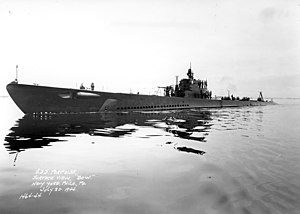 USS Porpoise on 20 July 1944
| |
| Class overview | |
|---|---|
| Name | Porpoise class |
| Builders | Electric Boat Company, Portsmouth Naval Shipyard, Mare Island Naval Shipyard[1] |
| Operators | |
| Preceded by | Cachalot class[1] |
| Succeeded by | Salmon class[1] |
| Built | 1933–1937[2] |
| In commission | 1935–1945[2] |
| Completed | 10[1] |
| Lost | 4[1] |
| Retired | 6[1] |
| General characteristics P-1 Type | |
| Type | Diesel-electric submarine |
| Displacement | 1,316 tons surfaced[3] 1,934 tons submerged[3] |
| Length |
|
| Beam | 24 ft 11 in (7.59 m)[3] |
| Draft | 14 ft 1 in (4.29 m) maximum[3] |
| Propulsion |
|
| Speed | |
| Range | |
| Test depth | 250 ft (80 m)[3] |
| Complement | 54[3] -55[5] |
| Armament |
|
The Porpoise class were submarines built for the United States Navy in the late 1930s, and incorporated a number of modern features that would make them the basis for the subsequent Salmon, Sargo, Tambor, Gato, Balao, and Tench classes. In some references, the Porpoises are called the "P" class.[7]
- ^ a b c d e f Bauer, K. Jack; Roberts, Stephen S. (1991). Register of Ships of the U.S. Navy, 1775–1990: Major Combatants. Westport, Connecticut: Greenwood Press. p. 269. ISBN 0-313-26202-0.
- ^ a b Friedman, Norman (1995). U.S. Submarines Through 1945: An Illustrated Design History. Annapolis, Maryland: Naval Institute Press. pp. 285–304. ISBN 1-55750-263-3.
- ^ a b c d e f g h i j k l m n Miller, David (2001). The Illustrated Directory of Submarines of the World. London: Greenwich Editions. ISBN 0-86288-613-9.
- ^ Lenton, H. T. American Submarines (New York: Doubleday, 1973), p.39.
- ^ a b Lenton, p.39.
- ^ a b Friedman, p. 310
- ^ Silverstone, pp. 189-190